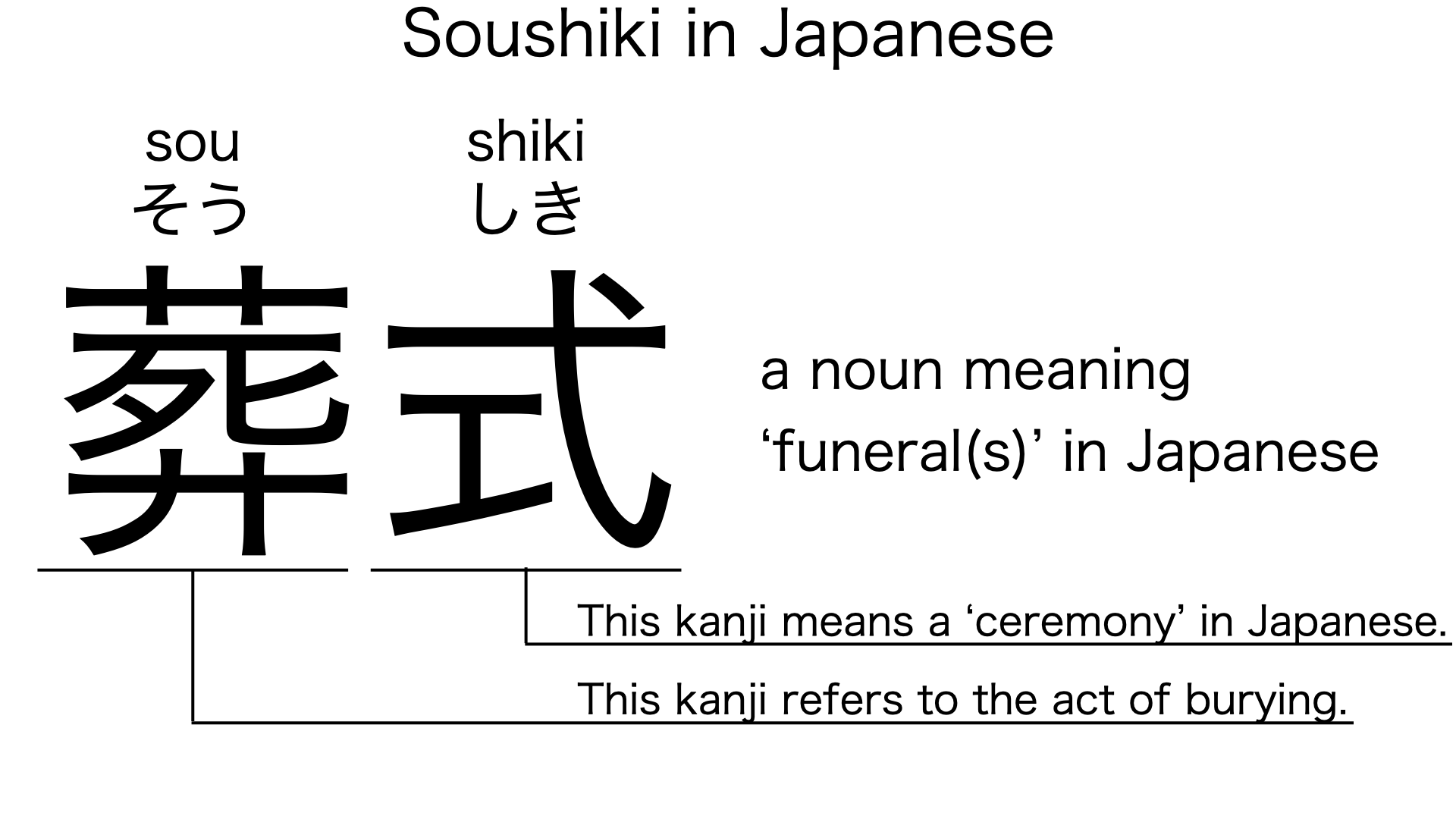What does “soushiki” mean in Japanese?
Native speakers use soushiki to mean a ‘funeral’ in Japanese. Perhaps, some Japanese learners know this word as it is sometimes used in Japanese movies, novels, manga, anime, and the like. In this blog post, however, I will explain this word in detail based on its kanji expression. And also, I will explain how to use it through example sentences. My explanations would help Japanese learners understand soushiki more clearly. Then, let’s get started!
Contents
Definition and meaning of “soushiki”
Let me start with the definition and meaning of soushiki.
- soushiki – 葬式 (そうしき) : a noun meaning a ‘funeral’ in Japanese. This can also work as plural. Learn more about Japanese plural.
The definition and meaning are simple and clear. To understand this noun more clearly, however, let me explain its kanji characters in detail, one by one.
Soushiki in kanji
The kanji expression of soushiki consists of the following two kanji characters:
- 葬 : a kanji character sometimes used to refer to the act of burying.
- 式 : a kanji character used to mean a ‘ceremony’ in Japanese.
From these two kanji characters, we can understand that soushiki literally means a ‘burying ceremony’ in Japanese. This literal interpretation is not completely in line with the actual meaning, but still very close, I think.

When we meet new kanji expressions, we should check their kanji characters in detail to understand their meanings clearly and deeply. In many cases, kanji characters tell us a lot about the meanings of the expressions they form. Actually, here, we could get the better understanding of soushiki through the detailed kanji check above.
So far, I’ve explained the definition and meaning of soushiki together with its kanji characters. Then, let me explain how to use it through the example sentences below.
How to say “funeral” in Japanese
watashi tachi wa kinou soushiki ni it ta – 私達は昨日葬式に行った (わたしたちはきのうそうしきにいった)
We went to the funeral yesterday.
Below are the new words used in the example sentence.
- watashi – 私 (わたし) : a pronoun meaning ‘I’ in Japanese.
- tachi – 達 (たち) : a suffix used after a noun or pronoun to make its plural form. In the example, this is used after watashi to make its plural form, watashi tachi, which means ‘we’ in Japanese.
- wa – は : a binding particle working as a case marker or topic marker. In the example, this works after watashi tachi to make the subject in the sentence.
- kinou – 昨日 (きのう) : a noun meaning ‘yesterday’ in Japanese. This can also work as an adverb almost anywhere in a sentence. In the example, this works as an adverb in the middle of the sentence to mean ‘yesterday’ in Japanese.
- ni – に : a case particle used to say where someone or something goes. In the example, this is used after soushiki to say where the speakers went yesterday.
- it – 行っ (いっ) : one conjugation of the verb, iku, which means ‘to go’ in Japanese. In the example, it has been conjugated for the better connection with its following word.
- ta – た : an auxiliary verb used after a verb, adjective, or auxiliary verb to make its past tense form. In the example, this is used after it to make its past tense form, it ta.
This is a typical usage of soushiki. In the example, it works together with the case particle, ni, to mean ‘to the funeral’ in Japanese.
Another example of “soushiki”
kanojo ga soushiki ni ko nakat ta – 彼女が葬式に来なかった (かのじょがそうしきにこなかった)
She didn’t come to the funeral.
Below are the new words used in the example sentence.
- kanojo – 彼女 (かのじょ) : a pronoun meaning ‘she’ in Japanese.
- ga – が : a case particle used to make the subject word or the object word in a sentence. In the example, this is used after kanojo to make the subject in the sentence.
- ko – 来 (こ) : one conjugation of the verb, kuru, which means ‘to come’ in Japanese. In the example, it has been conjugated for the better connection with its following word.
- nakat – なかっ : one conjugation of the auxiliary verb, nai, which is used after a verb, adjective, or auxiliary verb to deny its meaning. In the example, this is used after ko to deny its meaning.
This is another example of soushiki. When we want to mean a ‘funeral’ in Japanese, anyway, this noun is always a very good option.
Summary
In this blog post, I’ve explained the definition and meaning of soushiki in detail based on its kanji expression. And also, I’ve explained how to use it through the example sentences. Let me summarize them as follows.
- soushiki – 葬式 (そうしき) : a noun meaning a ‘funeral’ in Japanese. This can also work as plural. These two kanji characters literally mean a ‘burying ceremony’ in Japanese. This literal interpretation is not completely in line with the actual meaning, but still very close, I think.
Hope my explanations are understandable and helpful for Japanese learners.
Leave a Reply